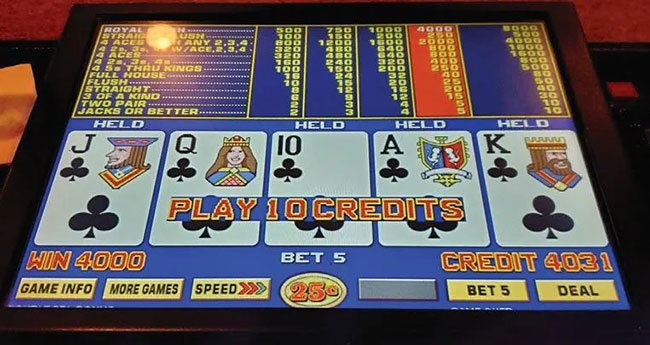The Best and Worst Video Poker Games in Las Vegas
Where to play, where to avoid, and how to win big!
By John Mehaffey
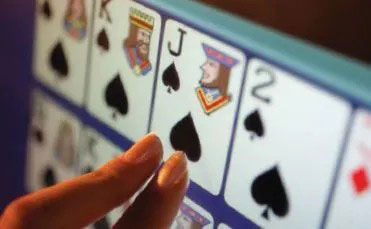 Las Vegas is home to some of the best video poker games in the world. It offers several pay tables that return over 100% with perfect play and five coins wagered.
Las Vegas is home to some of the best video poker games in the world. It offers several pay tables that return over 100% with perfect play and five coins wagered.
The options include full-pay Joker Poker, Double Bonus, Loose Deuces Wild and Double Double Bonus, found in the downtown and locals markets. The Las Vegas Strip does not have any 100% video poker pay tables.
This article will show you where to play the top video poker games in Vegas. See below the complete list of the Las Vegas casinos with the best and worst video poker tables.
BEST LAS VEGAS VIDEO POKER GAMES
Plaza Hotel & Casino in Downtown Las Vegas offers the best Las Vegas video poker game. It offers one full-pay Joker Poker machine. This game pays on a pair of kings or better.
The 20-coin payout for four of a kind sets it apart from other Joker Poker with this game. Quarter is the only denomination available.
Plaza moved coin versions of this game from Las Vegas Club when it closed in 2015. Circa opened on the former Las Vegas Club property in 2020.
In 2019, Plaza removed all coin-operated video poker and slots. The casino created a throwback version of the glass on the ticket-in-ticketout games that shows the paytable on the back glass.
Full-pay Joker Poker returns 100.65% with five coins wagered and perfect strategy used. However, it is impossible for a human to play the game without making some mistakes as the strategy has thousands of exceptions due to the frequency of penalty cards, especially when dealt the joker.
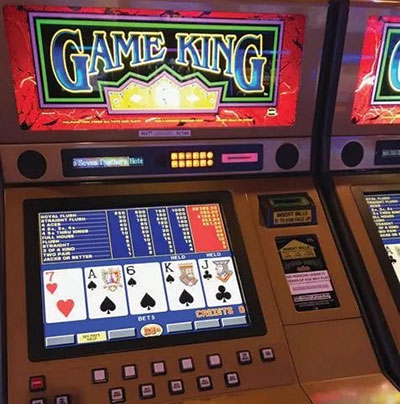 FULL-PAY JOKER POKER PAY TABLE
FULL-PAY JOKER POKER PAY TABLE
This Joker Poker pay table is the amount paid per coin wagered. Multiply the number of coins wagered by the payout to determine the win size. The royal flush payout assumes five coins wagered. It pays 400 per coin on bets of one to four coins.
- Natural Royal Flush: 800
- Five of a Kind: 200
- Wild Royal Flush: 100
- Straight Flush: 50
- Four of a Kind: 20
- Full House: 7
- Flush: 5
- Straight: 3
- Three of a Kind: 2
- Two Pair: 1
- Pair of Kings or Aces: 1
10/7 DOUBLE BONUS POKER
The second-best Las Vegas video poker game is more widely available. Most full-service Station Casinos properties have it. It is also found at Four Queens in Downtown Las Vegas and Emerald Island in downtown Henderson.
Double Bonus Poker doubles the payouts on all four-of-a-kind hands This game has a 10/7/5 pay table, meaning the full house pays 10 coins for every one bet, the flush is 7, while the straight pays 5. This changes the strategy in several ways. Players will hold more straight and flush draws due to the higher payouts. There are times when holding a three- card flush is the proper play.
At Boulder Station, Green Valley Ranch, Palace Station, Red Rock Resort, Santa Fe Station and Sunset Station, these games are on select 100% machines in the $0.25, $0.50 and $1 denominations. Four Queens has $0.25 and $1 versions available. Emerald Island offers 10/7 Double Bonus in the nickel denomination.
FULL-PAY DOUBLE BONUS POKER PAY TABLE
Full-pay Double Bonus Poker returns 100.17% with five coins wagered and perfect strategy used. The list below shows the amount paid per coin wagered. A royal flush pays 250 on bets of one to four coins.
- Royal Flush: 800
- Straight Flush: 50
- Four Aces: 160
- Four 2s, 3s or 4s: 80
- Four 5s to Kings: 50
- Full House: 10
- Flush: 7
- Straight: 5
- Three of a Kind: 3
- Pair of Jacks or Better: 1
LOOSE DEUCES
Full-pay Loose Deuces Wild is a game with a higher variance than the standard version. Four Deuces pays 2.5 times more on Loose Deuces than on Deuces Wild. A flush, full house and straight flush are lowered to make up for that. Loose Deuces is found on 100% machines at Boulder Station, Green Valley Ranch, Palace Station, Red Rock Resort, Santa Fe Station and Sunset Station. Quarter is the only denomination available.
FULL-PAY LOOSE DEUCES WILD PAY TABLE
Full-pay Loose Deuces Wild returns 100.15% with perfect play and five coins wagered. The royal flush pays 250 on one to four coins.
- Natural Royal Flush: 800
- Four Deuces: 500
- Wild Royal Flush: 25
- Five of a Kind: 15
- Straight Flush: 8
- Four of a Kind: 4
- Full House: 3
- Straight: 2
- Three of a Kind: 1
10/6 DOUBLE DOUBLE BONUS POKER
Another 100% game available only at Station Casinos is 10/6 Double Double Bonus Poker. It pays double bonuses on four aces, twos, threes or fours when the kicker is one of those cards compared to the quad payouts on Double Bonus Poker where kickers do not matter.
A straight flush pays 50 coins on this version, which is consistent with other video poker games with no wild card. This game is on 100% machines at Boulder Station, Green Valley Ranch, Palace Station, Red Rock Resort, Santa Fe Station and Sunset Station.
FULL-PAY DOUBLE DOUBLE BONUS PAY TABLE
- Royal Flush: 800
- Straight Flush: 50
- Four Aces with a 2, 3 or 4 Kicker: 400
- Four Aces: 160
- Four 2s, 3s or 4s with an A, 2, 3 or 4 Kicker: 160
- Four 2s, 3s or 4s: 80
- Four 5s to Kings: 50
- Full House: 10
- Flush: 6
- Straight: 4
- Three of a Kind: 3
- Two Pair: 1
- Pair of Jacks or Better: 1
Emerald Island and Rainbow Club also have 10/6 Double Double Bonus Poker. However, a straight flush only pays 40 coins. It is available at these casinos in Spin Poker, Triple Play, Five Play and Ten Play versions.
The 3/5/10 Play games permit up to 30 coins per line and have $0.01, $0.02 and $0.05 denominations. These are the best multi-hand video poker machines in the Las Vegas market. Arizona Charlie’s Decatur also has 10/6 Double Double Bonus Poker with the 40-coin straight flush. It is available in quarters.
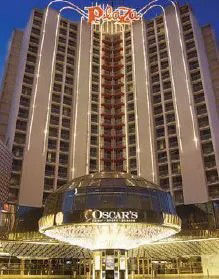 SAM’S TOWN HAS THE BEST LAS VEGAS PROGRESSIVE
SAM’S TOWN HAS THE BEST LAS VEGAS PROGRESSIVE
Sam’s Town offers the best Las Vegas video poker progressive. A bank of machines in the back of the casino has quarter 9/7 Double Bonus Poker, which matches the 10/7 pay table mentioned earlier, except a full house only pays nine coins. This game would normally only return 99.11%.
However, the progressive royal flush jackpot resets at $1,500, adding 1% to the return in addition to the increased meter as it is played. Standard quarter royal flush progressives start at $1,000.
FULL-PAY DEUCES WILD IS NO LONGER AVAILABLE
Full-pay Deuces Wild was available at Station Casinos, Sam’s Town, Arizona Charlie’s and Skyline. This game paid five coins on four of a kind. Most casinos downgraded this game in the 2010s. In 2023, Sam’s
Town removed its bank of full-pay Deuces Wild. It was the last Las Vegas casino with this game.
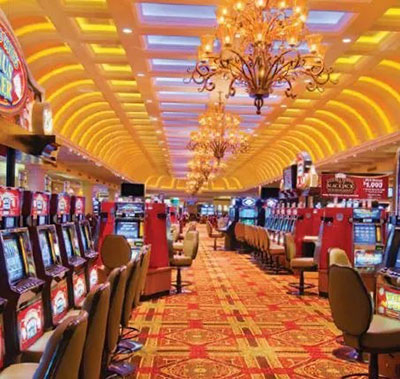 OTHER QUALITY VIDEO POKER GAMES
OTHER QUALITY VIDEO POKER GAMES
Most locals casinos have banks of “Up to 99.8%” video poker machines. This includes most Station Casinos, Boyd Gaming properties and M Resort. The titles include 99% and better versions of:
- Triple Bonus Plus
- Not-So-Ugly Deuces Wild
- Super Double Bonus
- Bonus Poker Deluxe
- Jacks or Better
- Aces and Faces Double Double Bonus
- Deuces Wild Bonus Poker
- ACE$ Poker
The denominations are usually $0.25, $0.50 and $1. These machines generally accept players cards. However, using one may hurt your future offers.
HIGH LIMIT VIDEO POKER
Most of the best Las Vegas video poker is available in denominations from $0.25 up to $1. Higher limits usually have lesser pay tables. South Point and Plaza offer some 99.5% and better games at the $2 denomination, like Jacks or Better and Bonus Poker Deluxe. Plaza also has $5 versions of these games.
On the Strip, 9/6 Jacks or Better is available starting at the $5 denomination at Caesars Palace, Cosmopolitan, MGM Grand and Wynn. Venetian has it at $10 and higher denominations.
The best high-limit Las Vegas Strip video poker is 9/7 Triple Double Bonus. It returns 99.58% with five coins and perfect play used.
This game has wild variance because four aces with a kicker pays the same as a royal flush. In exchange for this, three of a kind only pays two coins. It is available in $25, $50 and $100 denominations. This means the betting range to get the full payout on a royal flush is $125 up to $500.
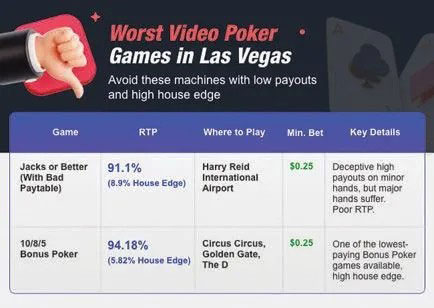 WORST LAS VEGAS VIDEO POKER
WORST LAS VEGAS VIDEO POKER
While there are many great Las Vegas video poker games where the player has an advantage, many more hold over 5%. Most are on nickel and dime machines. A few are on bar tops. These are the worst video poker games in Las Vegas.
The worst Las Vegas video poker is in unconventional places. One is a poker site that combines a pay table with heads-up and three-handed all-in action. The other is also not in a casino.
REAL GAMING
Real Gaming was a regulated Nevada poker site that failed in the mid-2010s. It came back to life in 2024 by partnering with several independent Nevada casino companies, like Plaza and Rampart. Players bet $2 per hand. Half goes to a heads-up or three-handed poker game with no rake.
The other applies to a pay table that only pays on a pair of jacks or better, three of a kind, full house, four of a kind and a royal flush. Two pair, straights, flushes and straight flushes do not get paid.
This was the pay table during a December 2024 review:
- Royal Flush: 4,500
- Four of a Kind: 70
- Full House: 15
- Three of a Kind: $3.50
- Pair of Jacks or Better: $0.50
This returns 87.65% with perfect play, which includes major changes to account for the massive royal flush payout that makes up over 15% of the return. That makes it the worst video game in Las Vegas with a variance over 30 times higher than major titles like Jacks or Better and Bonus Poker.
As if a 12.35% house advantage is not bad enough, Real Gaming charges deposit fees. If you manage to win against all odds, the site also has withdrawal fees.
 THE AIRPORT
THE AIRPORT
Another terrible video poker option is Harry Reid International Airport. While some older machines have 96%-97% pay tables, newer ones hold 8% or more. The worst example of this is a Jacks or Better game with the following payouts per coin:
- Royal Flush: 800
- Straight Flush: 80
- Four of a Kind: 25
- Full House: 10
- Flush: 7
- Straight: 5
- Three of a Kind: 3
- Two Pair: 1
- Pair of Jacks or Better: 1
At first glance, the 10/7/5 paytable looks great. However, paying only one coin on two pair destroys the game’s return since special quad payouts are missing. With perfect play, which must be adjusted for the larger flush and straight payouts, the game holds 8.9%. Other games on newer machines are only slightly better. If you must play video poker while waiting on a flight, choose the older cabinets.
10/8/5 BONUS POKER
Like the Jacks or Better game described above, there is an unusual ripoff version of Bonus Poker. It is on bartops at Circus Circus and some downtown casinos, like Golden Gate and The D. It is also on some nickel and dime machines downtown and on the Las Vegas Strip.
This is the Bonus Poker pay table to avoid. It holds 5.82%.
- Royal Flush: 800
- Straight Flush: 50
- Four Aces: 80
- Four 2s, 3s or 4s: 50
- Other Quads: 25
- Full House: 10
- Flush: 8
- Straight: 5
- Three of a Kind: 3
- Two Pair: 1
- Pair of Jacks or Better: 1
There are plenty of better options downtown, even on the same machines. For example, at Golden Gate and The D, choose 8/6 Bonus Poker Deluxe, which only holds 1.51%. At Circus Circus, play 99% games on the Slots A Fun bar top.
If you are playing nickel and dime games, the pay tables have a lower expected loss at those limits than moving up to higher denominators. However, some of these nickel and dime games require 10 coins to receive a full royal flush payout.
These machines often have slightly better games, like 7/5 Jacks or Better, 6/5 Double Double Bonus and 6/5 Bonus Poker Deluxe. These hold about 4%-5%.
LAS VEGAS TAVERNS AND STORES
Taverns and stores often have video poker. These games are always worse than what is available at locals casinos and are sometimes as bad as the airport machines. For the best payouts, avoid gambling in these unconventional gaming areas.
OTHER CONSIDERATIONS
While pay tables are the most important aspect of video poker, there are other considerations. Players should learn the strategy of the games they play.
The more mistakes made, the higher the house advantage is. Pay attention to progressive meters. Games with multiple meters beyond the royal flush, like for special quads and a straight flush, may have a worse pay table, but the meters may make up for that and beyond.
Players clubs award slot points on most video poker machines. This can cut the house edge by as much as half. Bounceback mailers can also increase the return through free slot play, comped meals and hotel offers.
Don’t play a higher denomination just because the pay table is better. A quarter game that holds 3% has a lower expected loss per hand than a dollar game that only has a 1% house edge. The quarter player on the 3% game loses just under $0.04 per hand at the $1.25 maximum bet. The dollar player loses $0.05 on a 1% game at the $5 maximum bet.
Run the math between denominations to determine if you should play higher, and always ensure you have the bankroll to withstand the variance.
John Mehaffey serves as the Editor-in-Chief at www.OnlineUnitedStatesCasinos.org,, bringing over two decades of experience and respect within the U.S. casino community. Renowned for breaking industry news, John has established himself as a trusted authority on both online and Las Vegas casinos. Since 2001, he has been actively engaging with online gaming for real money while sharing his insights through compelling writing. Based in Las Vegas, John continues to explore and report on the evolving world of online and brick-and-mortar casinos.


